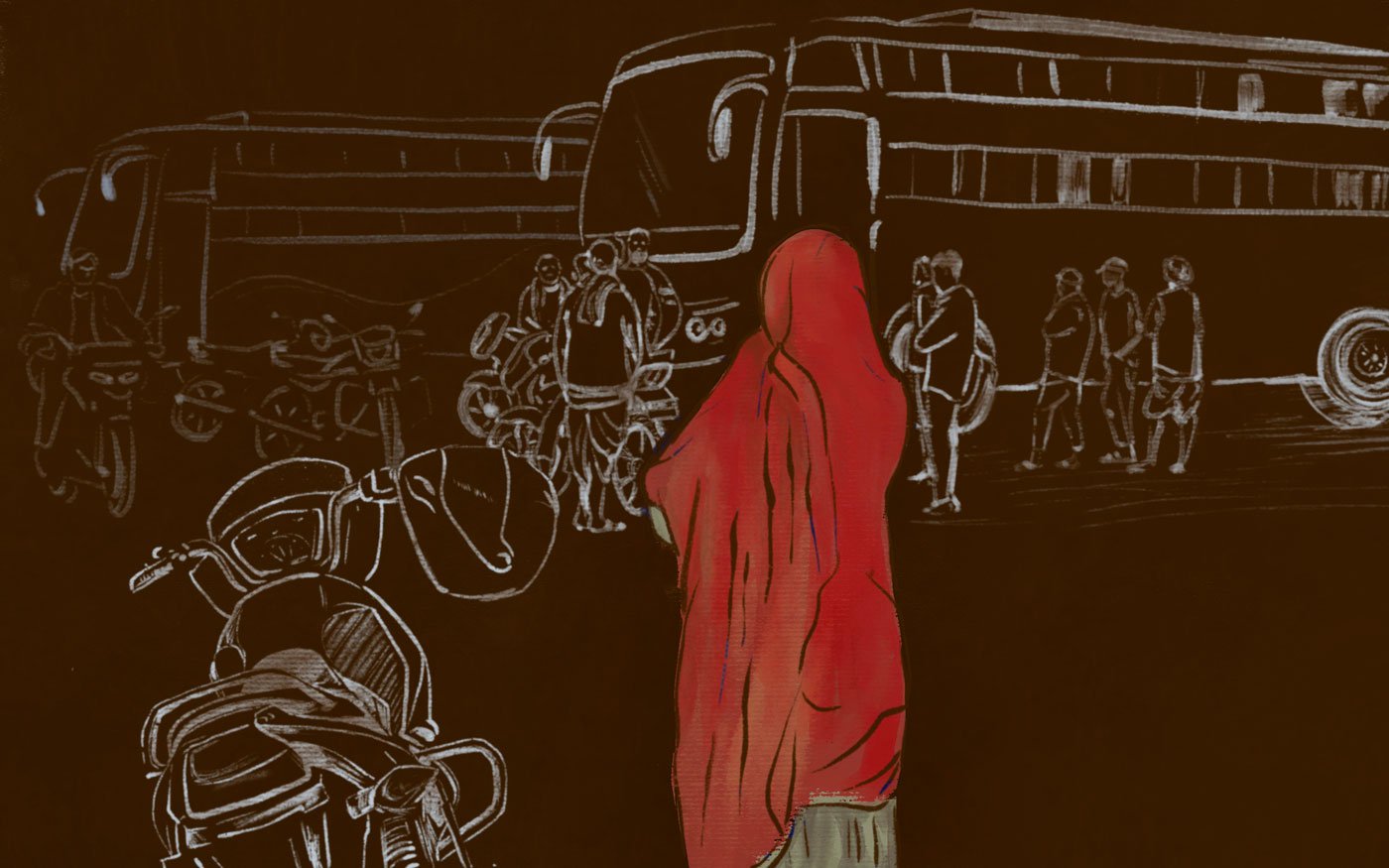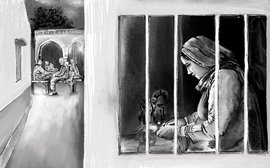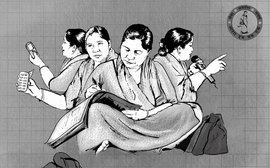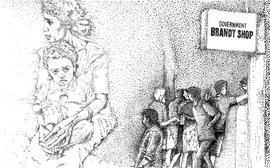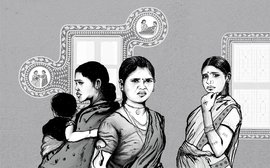The first time Diya almost got away.
She was seated in the bus, nervous, waiting for it to fill up. She had bought a ticket from Surat to Jhalod. From there, she knew it was an hour's ride to cross the Gujarat border to her home in Kushalgarh, Rajasthan.
She was looking out of the window when Ravi suddenly came from behind her. Before she could react, he dragged her off the bus, pulling her by the hand.
People around were busy loading luggage and managing children. No one paid attention to the angry young man and the frightened teenager. “I was scared to shout,” Diya says. It was best to stay quiet given her past experience of Ravi’s temper.
That night, back at the construction site, her home and prison for the last six months, Diya couldn’t sleep. Her body hurt all over. The beating by Ravi had split her skin in places and given her bruises. “He used his fists and even kicked me,” she remembers. "Nobody could stop him.” Men who intervened were accused of having their eye on her. Women who saw the abuse kept their distance, frightened by the violence. If someone dared to object, Ravi would say, ‘ Meri gharwali hai, tum kyon beech mein aa rahe ho [She is my wife. Why are you interfering]?
“Every time I was beaten, I would need to go to hospital for mallam patti [dressing the wound], and spend 500 rupees. Ravi’s brother would sometimes give the money, even accompany me to the hospital and say, “ tum ghar pe chale ja [just go to your parental home],” says Diya. But neither knew how she would pull it off.


Kushalgarh town in southern Rajasthan has many bus stations from where migrants leave everyday for work in neighbouring Gujarat. They travel with their families
Diya and Ravi are Bhil Adivasis from Rajasthan’s Banswara district, which has the second highest number of poor people in the state, says this 2023 multidimensional poverty report . The small landholdings, lack of irrigation, absence of jobs and overall poverty make Kushalgarh tehsil a hub for distress migration among the Bhil tribals, who make up 90 per cent of the population.
Like many others, Diya and Ravi would appear to be another migrant couple, looking for work on construction sites in Gujarat. But Diya’s migration was also an abduction.
Two years ago, 16-year-old Diya was a Class 10 student in a school in neighbouring Sajjangarh when she first met Ravi in the market. An older woman from the village had handed over his number on a piece of paper and insisted she see him, saying the young man just wanted to talk to her.
Diya didn’t call him. But, the next week when he came to the market, she spoke briefly to him. “ Humko ghumne le jayega bola, Bagidora. Bike pe . [He said we would go for a spin on the bike to Bagidora]. I was told to come out at 2 p.m., an hour earlier from school,” she recalls. The next day he was waiting outside her school, with a friend.
“We didn’t go to Bagidora [an hour away]. We went to the bus stand and he made me get on a bus to Ahmedabad,” she says, 500 kilometres away, in the next state.
A panicked Diya managed to make a phone call to her parents. “My chacha [paternal uncle] came to pick me up in Ahmedabad. But Ravi had already heard the news from his friends back home, so he dragged me to Surat.”
After that he became paranoid about her speaking to anyone, and the violence started. Asking for a phone to make a call would invite more violence. Diya remembers a day when desperate to talk to her family, she was crying and begging for his phone when, “he pushed me off the terrace of the first floor of the site. Luckily, I landed on a heap of rubble, completely bruised all over,” she recalls, showing parts of her back that still hurt.


Left: A government high school in Banswara district. Right: the Kushalgarh police station is in the centre of the town
*****
When she first learnt of Diya’s abduction, her mother Kamala, a 35-year-old daily wage worker, tried to get her back. Now speaking at the family’s kuccha single-room hut in a hamlet in Banswara district, the mother remembers crying uncontrollably: “ Beti toh hai meri. Apne ko dil nahin hota kya [Afterall she is my daughter. Will my heart not want her back]?”
A few days after Ravi took Diya, Kamala filed a police complaint against him.
Rajasthan records the third highest number of cases of crimes against women. However, its record in charge sheeting these crimes is the lowest at 55 per cent ( Crimes in India 2020 , published by National Crimes Records Bureau). Two out of three complaints for kidnapping and abduction don’t make it to a police case file. Diya’s case did not make it as well.
“They took back the case,” recalls Roop Singh, Deputy Superintendent of Police in Kushalgarh. Kamala says the banjadia – a group of village men who function as an extra-judicial court – got involved. They persuaded Kamala and her husband Kishan (Diya’s parents) to settle the matter without the police by asking for a ‘bride price’ – a system among the Bhils where the boy’s family pays for a wife. (Incidentally, when the men end the marriage, they demand the money back so that they can marry again.)
The family says they were asked to take Rs. 1-2 lakh and drop the police case of abduction. The ‘marriage’ had now received social sanction, Diya’s underage status and her consent were completely disregarded. In Rajasthan, a quarter of women aged 20-24 years are married before 18 years, says the most recent National Family Health Survey for 2019-2021 ( NFHS-5 ).
Teena Garasiya is a social worker in Kushalgarh. A Bhil Adivasi herself, she is not willing to to pass off cases like Diya’s as mere runaway brides. “Most cases that come to us, I never get the feeling that the girls have gone of their own accord. Or they have gone thinking of any benefit, or even love or happiness in the relationship,” says the head of Aajeevika’s Livelihood Bureau in Banswara district; she has been working with migrant women for over a decade.
“I see their going away as a conspiracy, a strategy for trafficking. There are people within, who bring girls into these relationships,” Teena adds, claiming money changes hands even for an introduction to the girl. “If a girl is 14-15 years, what understanding do they have of relationships? Of life?”
On a January morning, in Teena’s office in Kushalgarh, three families have come with their daughters. Their stories are similar to Diya’s.


Left: Teena Garasia (red sweater) heads Banswara Livelihood Bureau's Migrant Women Workers Reference Center; Anita Babulal (purple sari) is a Senior Associate at Aaajevika Bureau, and Kanku (uses only this name) is a sanghatan (group) leader. Jyotsana (standing and in a brown jacket) also from Aajeevika, is a community counselor stationed at the police station, and seen here helping families with paperwork
Seema was married at 16 and migrated to Gujarat for work with her husband. “He was obsessively jealous if I spoke to anyone. Once he hit me so hard, I still can’t hear from that ear properly,” she says.
“The beatings were terrible. It used to hurt so much I couldn’t get up from the floor and then he would say she is a kaamchor [shirker]. So, I worked with the injuries,” she adds. Her earnings went straight to him and “he wouldn’t buy even atta [flour], spending it all on alcohol.”
She finally managed to leave him after threatening to end her life. Since then he has been living with another woman. “I’m pregnant, but he is not willing to end our marriage or give me money to live,” she says. Her family has filed a first information report (FIR) for abandonment. The Protection of Women from Domestic Violence Act , 2005 section 20.1 (d) says maintenance must be provided, and it corresponds to Section 125 of the Criminal Procedure Code (CrPC).
Rani, also 19 years old, is mother to a three-year-old and pregnant with her second child. She too has been abandoned by her husband, but not before she went through verbal and physical torture. “He would drink every day and start a fight calling her, ‘ gandi aurat, randi hai [dirty woman, a prostitute],” she says.
Although she filed a police complaint, it was withdrawn when the banjadia brokered a deal on a 50-rupees stamp paper where the husband’s family promised he would behave. A month later when the harassment started again, the banjadia turned a blind eye. “I have gone to the police, but because I withdrew my earlier complaint, the evidence is lost,” says Rani, who never went to school but is learning the legal ropes. The literacy rate of Bhil women is an abysmal 31 per cent (Statistical Profile of Scheduled Tribes, 2013).
At the Aajeevika Bureau office, team members offer legal and overarching support to women like Diya, Seema and Rani. They have even printed a small booklet, Shramik mahilaon ka surakshit pravas [Safe migration for women labourers], that uses photos and graphics to inform women of helplines, hospitals, labour cards and more.
But for survivors, it’s a long road ahead with countless trips to police stations, courts and no clear end in sight. With the additional responsibility of young children, many cannot migrate again for work.
![The booklet, Shramak mahilaon ka surakshit pravas [Safe migration for women labourers] is an updated version of an earlier guide, but targeted specifically for women and created in 2023 by Keerthana S Ragh who now works with the Bureau](/media/images/05a-PDF-Pg-1-PD-In_Banswara-domestic_ties_.max-1400x1120.jpg)
![The booklet, Shramak mahilaon ka surakshit pravas [Safe migration for women labourers] is an updated version of an earlier guide, but targeted specifically for women and created in 2023 by Keerthana S Ragh who now works with the Bureau](/media/images/05b-PDF-Pg-14-PD-In_Banswara-domestic_ties.max-1400x1120.jpg)
The booklet, Shramik mahilaon ka surakshit pravas [Safe migration for women labourers] is an updated version of an earlier guide, but targeted specifically for women and created in 2023 by Keerthana S Ragh who now works with the Bureau


Left: Menka, also from Aajeevika (in the centre) holding a afternoon workshop with a group of young girls, discussing their futures and more. Right: Teena speaking to young girls
Teena says, “we have seen cases where the girls were persuaded to leave. Then they were passed on from one man to another. I feel if we call it out, it is nothing but taskari [smuggling] of girls. And it is on the rise.”
*****
In Ahmedabad and then Surat, soon after her abduction, Diya was put to work. She stood with Ravi and did rokdi – the couple were picked up by labour contractors from labour mandis (markets) for a daily wage of Rs. 350 to 400 each. They lived on the pavement in tarpaulin shanties. Later, Ravi got kayam which meant they were paid a monthly wage and lived at the construction site.
“[But] I never ever saw my earnings. He would keep it,” Diya says. After a day of hard physical labour, she would cook, clean, wash and do all household chores. Sometimes other women workers would come to try and chat, but Ravi watched her like a hawk.
“Three times my father sent money through somebody for me to leave. But as I would start moving out, someone would see and tell [Ravi], and he wouldn’t let me go. That time I got on the bus, someone told him and that’s how he came after me,” Diya says, of the time he dragged her back.
Finding help or accessing any state support for the violence or the abduction was impossible as Diya only spoke the dialect of Wangdi. In Surat, no one understood her. The contractors dealt with women only through the men, who had picked up Gujarati and Hindi.
Roughly four months after Ravi dragged Diya off the bus, she got pregnant; it was not of her own accord. The beatings slowed down but they didn’t entirely stop.
In the eighth month of her pregnancy, Ravi dropped her off at her parents’ home. On her due date they took her to a hospital in Jhalod (the closest big town) where her son was born. She could not breastfeed the child as he was in the intensive care unit (ICU) for 12 days, and she stopped lactating.


Migrant women facing domestic violence are at a double disadvantage – contractors deal with them only through their husbands, and the women who don't speak the local language, find it impossible to get help
At the time no one in her family knew of Ravi’s violent streak. After she had stayed for a while, the parents were eager for her to return to him. It is normal for young mothers who migrate to take their very young children with them. “ Sahara [support] for the girl is the man she has married,” Kamala explained. “They will live together, work together.” Staying with her parents, the mother and child were straining the family’s finances.
Meanwhile, the abuse had re-started, this time on the phone. Kamala recalls, “ bahut jhagda karte the [they used to argue a lot].” Ravi refused money for the child’s treatment. Diya, now home, had gained some courage and showed her independence. “Ok then I will ask my father,” she had shot back.
In one such conversation he told her he was going to go off with another woman. She replied, “If you can go, so can I [with another man].” And then she cut the call.
A few hours later, Ravi who was at his home in the neighbouring tehsil, landed up at her parental home with five other men, on three motorbikes. He persuaded her to come with him, saying he would behave, and they would go to Surat again.
“He took me to his home. They put my child on a cot. Mera gharwala [husband] slapped me, dragged me by the hair and took me into a room and shut the door. His brothers and friends also came in. Gala dabaya [He pressed my neck], and while the others held my hands to hold me down, he used his other hand to shave my head with a blade,” she remembers.
The incident is painfully etched in Diya’s memory. “I was pressed against a thamba [wooden pole]. I screamed and shouted as much as I could, but no one came.” Then the others left the room and shut the door. “He took off my clothes and raped me. He left, and three others came in and took turns to rape me. That’s all I remember because I became behosh [unconscious].”
When she came to her senses, she heard her infant son crying, and she later learnt that, “my gharwala [husband] had called my mother saying, ‘she is not coming. We will come and drop off the child’. My mother had refused and said she would come instead.”


Young mothers who migrate often take their very young children with them. In Diya's case, staying with her parents was straining the family’s finances
Kamala remembers that when she reached, Ravi told her to take the child. “I said ‘no’. I want to see my daughter.” A trembling Diya, her head shaved, “as if for a cremation,” came forward. “I called my husband, the s arpanch and mukhiya of the village, and they called the police,” Kamala recalls.
By the time the police arrived, the men who did this had disappeared. Diya was taken to a hospital. “I had bite marks,” she recalls. “No rape test was done. No photo was taken of my injuries.”
The Protection of Women from Domestic Violence Act , 2005, in Section (9g) clearly says the police must order a physical examination if there has been physical violence. Although her family says they told the police everything, when this reporter asked the Deputy Superintendent of Police in Kushalgarh, he claimed Diya had changed her statement, not mentioned rape and she sounded like she had been tutored.
Diya’s family vehemently deny this. “ Aadha aaadha likha aur aadha aaadha chorh diya [they wrote half and left half],” Diya says. “I read the file in court after 2-3 days. I saw they had not written that four people had raped me. Nor did they write the names, although I gave it.”
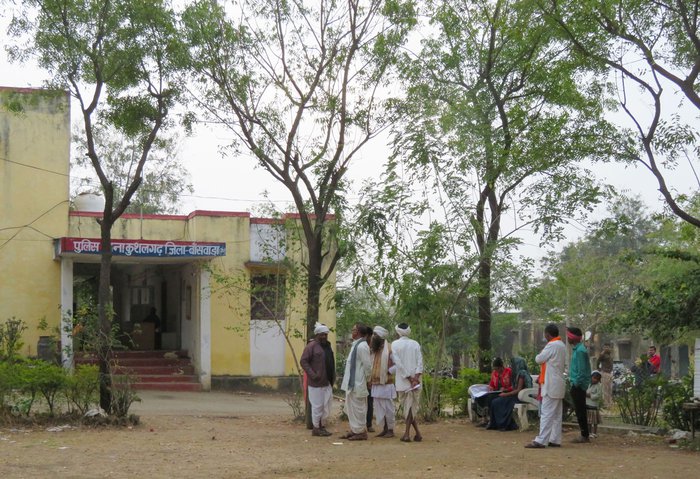
The Kushalgarh police station where the number of women and their families filing cases against husbands for abandonment and violence is rising
Migrant women facing domestic violence are doubly disadvantaged – contractors deal with them only through the men, and the women don't speak the local language so they can't ask for help
Ravi and the three men she told the police were her alleged rapists, were arrested. So were other members of his family. All are out on bail, and Diya hears from neighbours about threats on her life being made by Ravi’s friends and family.
In early 2024, when this reporter met her, she said her routine revolves around multiple trips to the police station and the court, and taking care of her now 10-month-old child who has been diagnosed with epilepsy.
“Each time we come into Kushalgarh [it takes] 40 rupees for each of us in the bus,” Diya’s father, Kishan, says. Sometimes the family is called urgently and they have to hire a private van which costs Rs. 2,000 for the 35 km journey from their home.
Expenses are mounting but Kishan has put a hold on his migration. “How can I migrate when this case is not final? But if I don’t work, how will we run the house?” he asks. “The banjadia offered us 5 lakh rupees to drop the case. My sarpanch told me, ‘take it’. I said no! Let him take the punishment as per the kanoon [law].”
Sitting on the mud floor of her home, Diya, now 19, hopes the accused will be punished. Her hair has grown an inch. “They did what they wanted with me. What is there to be scared about? I will fight. He should know what happens if he does something like this. Then he won’t do it again with someone else.”
Her voice rising, she adds, “he should be punished.”
The story is part of a nationwide reporting project focusing on social, institutional and structural barriers to care for survivors of Sexual and Gender-Based violence (SGBV) in India. It is part of a Doctors Without Borders India supported initiative.
The names of the survivors and family members have been changed to protect their identity .
